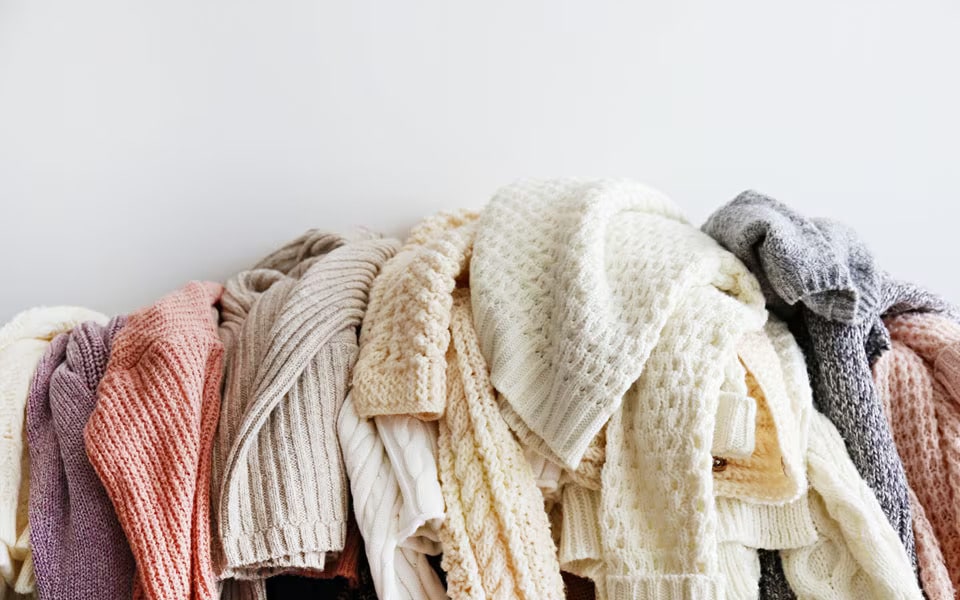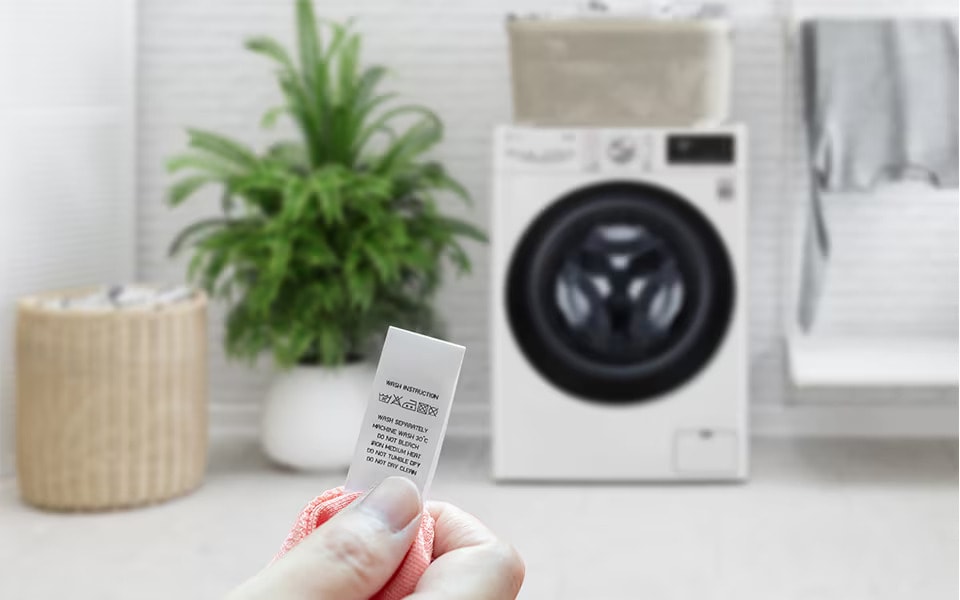We use cookies, including cookies from third parties, to enhance your user experience and the effectiveness of our marketing activities. These cookies are performance, analytics and advertising cookies, please see our Privacy and Cookie policy for further information. If you agree to all of our cookies select “Accept all” or select “Cookie Settings” to see which cookies we use and choose which ones you would like to accept.

Weighted blankets are popular because they reduce stress and anxiety and improve sleep quality. But how do you clean them? In this article, we'll guide you through the process of washing a weighted blanket and explain LG washing machines' material-specific cycles. It's essential to follow appropriate care methods for each material to ensure the blanket's longevity and effectiveness. We'll also cover washing methods for materials that are difficult to clean. By following these simple steps, you can keep your weighted blanket clean and comfortable for years to come.
How to Wash a Weighted Blanket with LG Duvet Cycle

A thick blanket, especially a weighted one, can be challenging to wash, but it's essential to maintain its therapeutic benefits and hygiene. A weighted blanket offers deep pressure touch, which promotes relaxation and improves sleep quality. So it's crucial to wash it properly to avoid damaging the machine or blanket and compromising its therapeutic benefits. Here are some steps to wash a weighted blanket:
Step 1: Check the care label carefully because it provides essential information on how to wash it properly. Some weighted blankets may require dry cleaning, while others may be machine washable.
Step 2: Check the weight of the laundry and verify if it can be washed in the washing machine. Overloading the washing machine can damage the machine or result in poorly washed clothes. Similarly, washing items that are not meant to be washed in the machine can damage the fabric.
Step 3: Use Mild Detergent. Using mild detergent prevents the blanket's fibers from breaking down, which can make the blanket scratchy. Avoid using fabric softeners and bleach as they can damage the blanket.
Step 4: Wash it using the Washing Machine. LG washing machines have a Duvet Cycle designed for items such as bed covers, sofa covers, and weighted blankets. It can also wash cotton bedding, but not delicate, wool, or silk garments. The Duvet Cycle allows you to adjust the temperature from cold to 40°C, and its maximum load capacity is 2.5kg, or one down duvet.
Step 5: To properly dry your blanket, use the Duvet Cycle on the LG dryer. This cycle is designed for bulky items like bed covers, sofa covers, and weighted blankets. Alternatively, you can use low heat and periodically stop the cycle to fluff up the weighted blanket so that it dries evenly. You can also air-dry the blanket on a large, clean surface.
Tips: Whenever spills or stains happen, you can also spot-clean the blanket as needed using a toothbrush dipped in a solution of warm water and mild detergent.
Using a removable duvet cover can cut down on the need for frequent washes, as it protects the blanket from spills and stains.
How often you should wash your weighted blanket depends on how frequently it is used. For daily use, wash every three weeks or as needed. For occasional use, wash every three to four months. If you exceed the recommended weight when washing, it can impact the performance of your washing machine. For heavy comforters, please hand wash or use a commercial washing machine.
Care Instructions for Weighted Blankets by Material
Cotton Batting Weighted Blankets
If your weighted blanket is made with cotton batting, you should avoid washing it with water as the natural cotton batting particles are weak and can clump together during washing. Instead, place the blanket under the sun for a few hours, and it will not only sanitize but also freshen up. Be sure to fluff the batting to prevent clumping. It is recommended to sanitize it once every few months.
Goose Down/Duck Down Weighted Blankets

For goose down or duck down weighted blankets, avoid using bleach and fabric softeners while washing. Washing in lukewarm water with neutral detergent on the wool/blanket cycle at 30°C is recommended. After spinning, gently separate clumped feathers by hand and ensure the blanket is entirely dry. Wash every 3-4 years to avoid decreased elasticity.
Microfiber Weighted Blankets
If your weighted blanket is made with microfiber, avoid washing it in hot water or boiling it, as it can cause shrinkage. Use lukewarm water and wash it alone with neutral detergent on the wool/blanket cycle. Don't use bleach or fabric softeners and avoid using powdered detergent because it can leave residue due to dust sticking to it. Gently spin dry and dry in a well-ventilated, shady area to prevent damage.
How to Wash Wool Blankets
Wool blankets are a cherished addition to any bedding collection, and they're known for their durability, softness, and warmth. However, to keep them in good condition and extend their lifespan, they require special care when washing. Using the right washing cycle is key to preventing damage to the wool fibers and ensuring that your wool blanket stays soft and cozy for years to come. Here's how to wash a wool blanket and ensure it stays in good condition for years to come.
Step 1: Shake and hang the blanket in a well-ventilated area to remove loose dirt and debris.
Step 2: Lay the blanket flat and use a soft-bristled brush to remove any embedded dirt, dust, or debris.
Step 3: Spot clean any stains on the blanket with cold water and a mild detergent, club soda, or a vinegar solution. Soak the area with the solution and blot it with a clean cloth.
Step 4: Fill the washing machine with cold water and a wool-safe detergent. Do not use hot water, as this can cause the wool to shrink. Soak the blanket in the machine for around 15 minutes before running the machine on a gentle cycle for a couple of minutes.
Step 5: After the cycle, switch the machine to the rinse cycle and let it finish.
Step 6: When drying your wool blanket, avoid putting it in the dryer, as this can destroy the softness and shape of the wool fibers. Instead, hang the blanket outside to air dry, but keep it out of direct sunlight. Alternatively, you can hang a slightly damp blanket to dry over a door, on a drying rack, or on a non-rusting shower or towel bar.
Washing Wool Blanket with LG Washing Machine
If you need to wash a wool blanket, the LG 24(60.96cm) washing machine's Hand/Wool cycle is a great option for a gentler wash. This cycle is specifically designed to handle wool garments and blankets with care, using lukewarm water at 30°C to prevent shrinking or felting. It's ideal for hand and machine-washable wool, lingerie, dresses, and other delicate items. The gentle agitation process helps to minimise excessive stretching or damage to the wool fibers during the wash cycle. Furthermore, using a wool-specific detergent can help to minimise damage or shrinkage while ensuring the blanket is thoroughly cleaned.
How to Wash Wool and Cashmere Sweaters

Wool and cashmere sweaters need special care to stay soft and maintain their shape. Some require dry cleaning, but others can be washed at home with the right technique. Read the care label before washing to determine the proper care instructions. This guide will explain how to use the Hand/Wool cycle of the LG 24(60.96cm) washer for wool and cashmere sweaters, so they'll look great for years to come.
Step 1: Prepare the sweater for washing on LG 24(60.96cm) washing machine's Hand/Wool cycle. Turn the sweater inside out and put it in a mesh laundry bag.
Step 2: Choose a wool-specific detergent that contains lanolin. Avoid using shampoo or neutral detergent as they can damage the knit of delicate clothes like wool and cashmere sweaters.
Step 3: Adjust the temperature and spin speed to your preference. The recommended temperature for the Hand/Wool cycle is 30°C, and it's recommended to rinse twice.
Step 4: After washing, remove the sweater from the washing machine and avoid wringing or twisting it. To avoid stretching, lay the sweater flat on a towel to air dry instead of hanging it.
Step 5: If you're using a dryer, it's recommended to leave 10-20% moisture remaining at the end of the drying process to avoid over-drying and prevent damage to your clothes.
Dry Clothes and Blankets while Minimising Damage

LG Heat Pump Dryers: Dehumidifying Function
LG dryers have a special feature called the Dual Inverter Heat Pump system. With this feature, you don't have to worry about heat damage to your clothes. You can also use the low-temperature dehumidifying function to remove moisture from the material. This function removes excess moisture from your clothes, leaving them dry, fresh, and ready to wear in no time. It's gentle on your clothes and only removes moisture from the fabric.
LG Dryers: Rack Dry Cycle
If you're looking for a way to dry items that can't be tumbled in your dryer, many LG dryer models offer a Rack Dry cycle. This cycle is specifically designed to dry items on a drying rack that fits inside the dryer, without tumbling them or exposing them to high heat. The low-speed spin and absence of heat help to minimise damage to delicate fabrics or items that could be damaged by tumbling or high heat. The length of the Rack Dry cycle may vary depending on the specific LG dryer model, the type of items being dried, and the amount of moisture in the items.
Cycles in LG Washing Machines
Even after checking the care labels on your clothes, the various settings on your washing machine can still be confusing. To help you choose the best wash programme for your laundry needs, let's review the most common ones.

Cotton
The Cotton Cycle is intended for normally soiled cotton garments and uses different drum motions to provide the best possible clean for cotton fabrics.
Mixed Fabric Cycle
The Mixed Fabric cycle can wash different fabrics simultaneously, except for delicate items such as silk, wool, sportswear, and dark clothes. It's ideal for washing a variety of fabrics.
Easy Care Cycle
The Easy Care cycle is intended for fabrics such as polyamide, acrylic, and polyester, which do not require ironing after washing.
Duvet
The Duvet programme is designed for large items such as bedspreads and pillows, making it ideal for spring cleaning after a long winter.
If you're still unsure which programme to select, choose the Mixed Fabric or Easy Care cycle as they can handle the majority of typical fabric types. For Cotton, Mixed Fabric, and Easy Care cycles, LG washing machines with AI DD™ technology will automatically detect the type of clothes and adjust the wash cycle accordingly for a thorough clean.
Download Cycle
Baby Care: Remove solid stains and provide better rinse performance for your baby's clothes.
Hygiene: Maintains water temperature 60°C throughout the wash cycle for sanitization.
Small Load: Washes a small load in a quick wash time.
Lingerie: Wash delicate clothes.
Skin Care: Efficiently removes detergent residue in clothes.
Cold Wash: Helps save energy while washing lightly soiled clothes.
Rinse+Spin: This cycle only rinses and spins. (No wash performance)
Kids Wear: This cycle helps remove heavy stains from children's clothes.
School Uniform: This cycle washes and removes light wrinkles in school uniforms.
Swimming Wear: This cycle helps remove chlorine or salt from swim wear.
Rainy Season: Minimizes moisture of clothes by increasing spinning power.
Gym Clothes: Wash sweat stained gym clothes except Gore-Tex clothes.
Jeans: This cycle is designed specifically for jeans. Recommend 20°C water for blue jeans.
Blanket: This cycle helps wash the blanket efficiently.
Sweat Stains: Wash clothes stained with sweat.
Single Garment: This cycle quickly washes a single item.
Color Protection: Wash clothes in cold water to protect vivid color.
Lightly Soiled Items: Wash your clothes delicately.
Minimize Detergent: Provide you with cleanly rinsing performance by one more rinsing.
'Download Cycle' allows you to download new wash cycles via the LG ThinQ app. The app provides wash cycles for every type of laundry, including Baby Care, Cold Wash, Colour Protection, Deodorisation, Jeans, Juice, Food Stains, Kids Wear, Lingerie, Rainy Season, Refresh, Single Garment, Sleeve Herms and Collars, Sportswear, Sweat Stain, Swimwear, and more.
The 'Download Cycle' button in LG washing machines initiates the Rinse + Spin cycle as the default setting. If you need to hand wash your clothes, you can rinse and drain the water from them by running this cycle after washing. This will make it easier for you to hang and dry them.123
LG washing machines with AI DD™ technology and the LG ThinQ app offer additional features that can help you customise your wash cycle to ensure a thorough clean for every type of fabric. So, don't be intimidated by your washing machine settings anymore, and enjoy freshly washed clothes with ease.
- 1. The Download Cycle is a feature that erases the existing downloaded cycle/Rinse+Spin cycle of the initial setting when a new cycle is downloaded, and the new course is activated.
- 2. Download Cycle functionality is only available on models with Wi-Fi.
- 3. The Cycle may vary by country and model.
